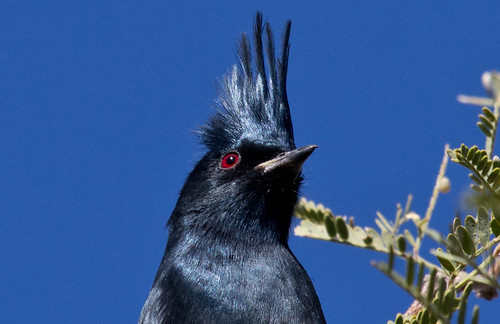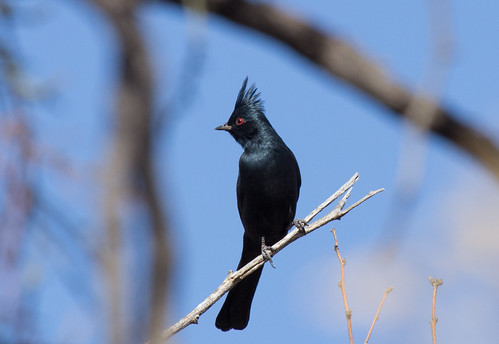Ever since the Phainopepla turned up outside Duluth last week, I've been thinking of when I first discovered this lovely bird. In 1982, when our baby Joey was 6 months old, Russ had a meeting in Las Vegas and we made it into a family vacation. This was the very first time I’d ever been in the Southwest, and I saw Phainopeplas first at Sunset Park in Las Vegas, and then in several places in southeastern Arizona.
Russ’s parents had gone to Arizona a year or two before we did that first time, and Russ’s dad was utterly taken with Phainopeplas. They often sit on conspicuous perches, and so are a characteristic desert bird that non-birders are likely to notice. But I think Russ’s dad especially liked their name. I remember him holding baby Joey and saying, “Did you see a Phain-o-PEP-la?” It’s a fun word that even my 2-year-old grandson Walter likes to say.
The unusual but cool-sounding word comes from the bird’s scientific name, Phainopepla nitens. In Greek, phainos means “shining,” and peplos means “robe.” In Latin, nitens also means “shining,” emphasizing that lovely quality of the adult male plumage.
The Phainopepla belongs to the silky-flycatcher family, which was once part of the waxwing family. Like waxwings, phainopeplas sally out to catch insects from conspicuous perches and then return where they started out or alight on another conspicuous perch.
Also like waxwings, Phainopeplas eat a lot of fruit. Phainopeplas are specialists on desert mistletoe, with a uniquely adapted stomach to extract as much nutrition from their berries as possible. The seeds and pulp hold almost all the nutrition, but the much less digestible skin makes those nutrients hard to access for animals that swallow berries whole. To get enough food value, Phainopeplas must eat a lot of mistletoe berries—as many as 1,100 in a single day. They devour enough to stuff their crop (a pouch in the esophagus) to capacity, and then retreat to a perch to quietly digest the feast.
The Phainopepla’s muscular stomach chamber, or gizzard, is very tiny, processing one berry at a time by contracting to squeeze the seed and semi-liquid pulp directly into the small intestine as the berry’s sturdy outer skin remains in the gizzard. One by one, the berries run through the gizzard like this, the digestible pulp and seeds extracted and running through the intestines as the skins accumulate in the gizzard in a compact mass. When that mass builds to about 10 or 20 packed skins, the gizzard ejects it into the small intestine in a bolus separate from the pulp and seeds. As far as I can find, the Phainopepla is the only known bird able to shuck the outer coatings of berries like this. Between swallowing the berry and it coming out the other end takes only about 12 minutes, making the system as fast as it is efficient.
Phainopeplas arrive on their breeding grounds in the United States between February and April. The birds in Arizona and California, the most well-studied populations, breed in two distinct habitats at two different times of the year. Between February and April, they breed in the Arizona's Sonoran Desert and California's Colorado Desert. In May, as summer heat intensifies and desert berry supplies dwindle, the birds appear in oak and sycamore canyons, where they breed through July.
Nesting Phainopeplas behave quite differently in the two habitats. In the desert, mated pairs are extremely territorial, probably because desert mistletoe parasitizes the same trees over and over, producing a stable, long-lasting supply of berries close to where each pair nests. But in the oak and sycamore woodlands where they breed in summer, Phainopeplas nest in loose colonies of from 3–15 pairs, feeding on such fruits as redberry and elderberry, which grow away from their shaded nest sites. In this habitat, foraging Phainopeplas lose less from sharing the fruits than they benefit from more eyes searching out new fruiting plants and noticing and helping one another to mob nest predators.
So far, researchers haven’t figured out whether the desert-nesting Phainopeplas in Arizona and California are the same individuals that nest in woodlands later the same years, or if these nesting styles represent two different breeding populations. Either way it's unique, befitting a bird with such a unique and fun-to-say name.



